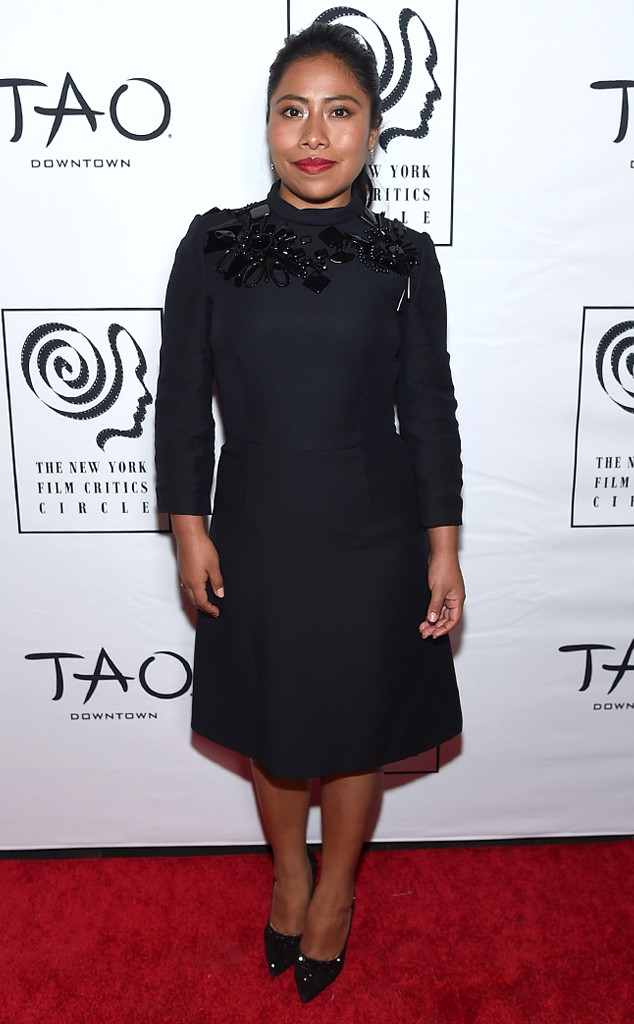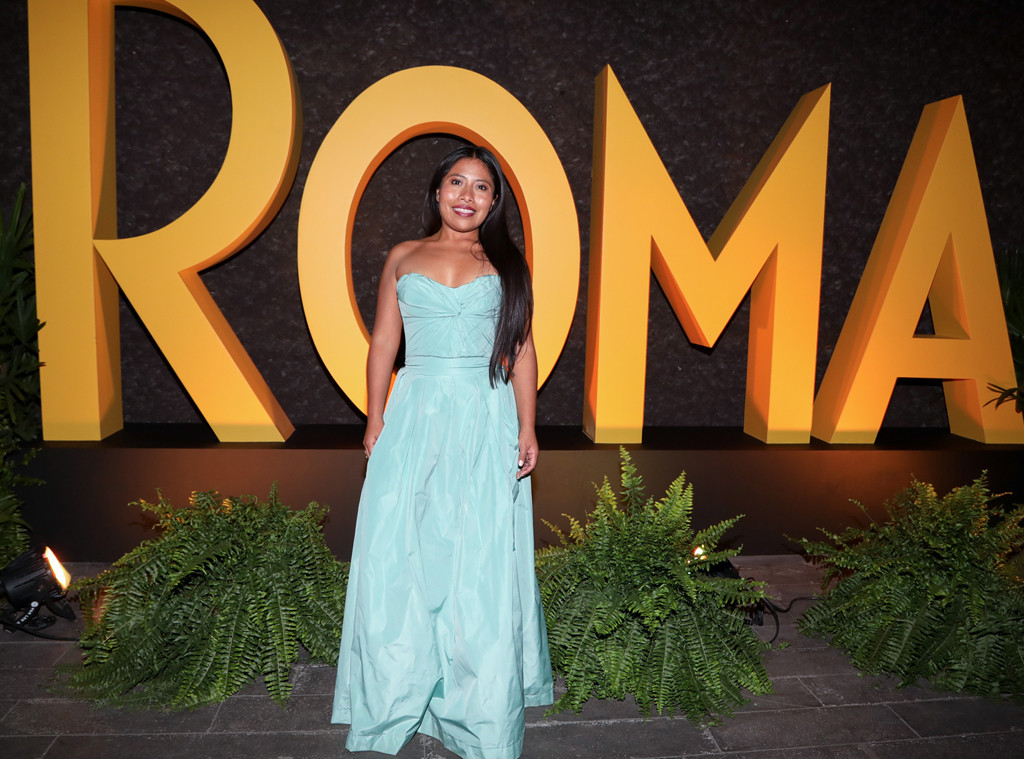
Jamie McCarthy/Getty Images
Yalitza Aparicio didn’t plan on auditioning for Roma. In fact, she didn’t even have plans to be an actor at all.
When casting on Alfonso Cuarón‘s highly personal film, based in part on his own childhood, came to her hometown of Tlaxiaco, Oaxaca in Mexico, she’d never even heard of the famed director. Instead, she was studying to be a school teacher and had to be convinced to attend the open casting call that she admittedly had suspicions might be a front for a trafficking scam.
And now, here she is, gracing the cover of Vogue Mexico—a historical moment for indigenous women like herself—traveling to Italy for the film’s world premiere at the 75th Venice International Film Festival, and, as of January 22nd’s Oscar nomination announcements, adding an achievement to her resume that she’d never even dreamed of: Academy Award nominee.
With her Best Actress nod, Aparicio becomes only the second Mexican-born actress to be recognized in the category, following in the footsteps of Salma Hayek (nominated in 2003 for Frida), and, in a story that seems only possible on the pages of a script, her road to Hollywood’s biggest night is nothing short of miraculous.
Cuarón’s film, named Roma as a nod to the Colonia Roma neighborhood of Mexico City where he grew up, is not only a love letter to his childhood, but also to the woman who helped raise him and his siblings—his nanny Liboria “Libo” Rodriguez. And as such, finding the picture perfect-person to play the indigenous Mixtec woman who joined his family when he was only nine months old—or rather his approximation of her, named Cleo in the film—was of the utmost importance.
And so a months-long search began, first in the cities of Mexico before venturing out into the villages, to find the actress who would strike Cuarón as Rodriguez’s doppelgänger. He personally monitored tapes of more than 3,000 women, never sparking to a single one.
“I was starting to get a bit nervous until suddenly Yalitza walks into the office, and it was that presence — kind of shy but very open,” he recalled to the New York Times this month of his first meeting with Aparicio at a callback.
Before Roma, Aparicio was not known as the performer in her family. That title was held by her older sister Edith, who, in 2016, was invited by the director of a Tlaxiaco cultural center to a mysterious casting call. “My sister sings, and in Mexico we have these things called Casa de la Cultura, which are specific places where they actually foster culture. They support people who want to do something in culture. The director of the Casa de la Cultura in my hometown invited my sister because he knew she sang, and my sister asked me to go with her,” she told Deadline in December.
And once at the audition, her sister pulled a bit of a bait-and-switch. “Once we were there she said, ‘OK, I’m not going to be able to do it because I’m pregnant, and you know that I’m not feeling very well anyway. So I want you to go in there; I want you to do the casting, I want you to answer everything they ask, and I want you to act if they ask you to act,'” she continued. “My sister thinks that I’m shy and don’t speak that much. So she wanted me to go through the experience. And also because she was very curious, as there has never been a casting before in our hometown. I didn’t want to do it, but I did.”
“Then it became an adventure,” she told W Magazine. Rounds of callbacks and screen tests eventually took Aparicio out of her small town at only 22. “There was a mixture of apprehension and curiosity,” she told Vox in November. “But because I went with my mom, I think I felt a little bit more secure.”
And even as the callbacks kept coming, she could never really get a gauge on where she stood. “After every screen test, my family would ask how it went, but I would just say that I didn’t know,” she told Variety last year. “At least I could visit more places with my mom.”
For Cuarón, however, once he met Aparicio, it was crystal-clear that he’d found his leading lady. “It was immediate,” he told Variety in a separate interview. “I’m talking about Libo. I’ve known her all my life. I know her attributes. I know her approach. I know that smile. So it was one of those things when you meet someone and you say, ‘Please, please, I hope she says yes.'”
But she didn’t. Not at first.
Having just received her teaching degree, but not yet stepping foot in a classroom, she had to weigh her options, she told the director. And she had to speak to her family. “We were all kind of in this state of shock. We couldn’t really believe it,” Aparicio told Variety. “My brothers asked me, ‘How are you going to do this?’ Because I’m very camera-shy and also the quietest member of the family. And so they were like, “What are you going to do when the camera starts rolling? Are you going hide?”
But she eventually called Cuarón back and let him know that his offer came at just the right time, as there was a gap before the application season for teaching jobs. “She says, ‘Well, I think I can do it,'” he told the NYT. “‘I have nothing better to do.'”
While she was certainly excited about the rare opportunity Cuarón had offered her, that feeling was sharing space in her mind with a whole host of others. “I was happy, but nervous because I had no idea whether I’d be able to achieve what I’d been asked to do by Alfonso. I was also a little sad,” she told The Guardian in November. “I’d just got my degree and I hadn’t yet worked as a teacher. I’ve still not worked as a teacher.”
Aparicio’s nerves likely weren’t settled when filming began, as the director famously did not provide his cast with a script, only giving them daily scenarios, shooting the film in chronological order and encouraging improvised dialogue in the hopes of fostering a truly naturalistic feel to the film. But in building the character of Cleo—something she’d never learned how to do or done before—she simply looked inward. “My life was similar. We were both poor, and we both wanted to go to Mexico City to improve our family’s lives,” she told The Guardian. That her mother worked as a nanny also helped. “She is still a domestic worker,” she added. “When I was younger, I used to help her so she could finish earlier.”
She also had to overcome her fear of the camera. “At first it was kind of scary and overwhelming, but I had to pretend like the cameras weren’t there,” she told Variety. “And as time went on, I got very good at that, at imagining that I was on set by myself, just performing day-to-day tasks.”
Filming had its share of obstacles to get over—including learning Mixtec, a language native to the Oaxaca region of Mexico, and shooting pivotal beach scene despite not knowing how to swim—but overcome them she did. And soon, as the film set out on the festival circuit last year, the role of a lifetime was taking her all over the world.

Victor Chavez/Getty Images for NETFLIX
“It’s like a dream that came true without me realizing it,” she told Variety. “I remember it was something I had wished for—traveling to different parts of the world—and it fills me with joy that through the film I can go to magnificent places. [In the past] I only went on school trips, to states close to Oaxaca.”
Then the accolades began pouring in, along with more opportunities, like this month’s Vogue Mexico cover. And all along the way, Aparicio’s begun to realize that she’s doing something quite important for people who look like her. “People that they [fashion magazines] portray always seem unreachable,” she told The Guardian. “So seeing a similar face is a way to tell people, ‘Yes, you can do it. You can dream about being on the cover of magazines, you can dream about being in a film.’ So that’s why it was important.”
Before the Oscar nomination was a reality, she’d been asked by the New York Times to postulate on what such a thing might mean should she find herself nominated amongst the likes of Glenn Close and Lady Gaga. “I’d be breaking the stereotype that because we’re Indigenous we can’t do certain things because of our skin color,” she told the newspaper. “Receiving that nomination would be a break from so many ideas. It would open doors to other people — to everyone — and deepen our conviction that we can do these things now.”
As for what the future holds, Aparicio’s really not sure. Though she’s yet to receive any other offers, she’s gone on record that she’d like to make more films, but there’s a sense of trepidation about working in an environment different from the one Cuaron created on the set of Roma. “I don’t know what it would be like to work with other directors,” she told The Guardian. “I believe each of them has their own way of working.”
And when it comes to teaching, she’s realized that there’s some commonality between the profession she pursued and the one that magically landed in her lap. “I believe acting and teaching are not so far apart. As a teacher, you educate. And films educate too, but they do it in a massive way,” she told Deadline, while noting in a separate interview with The Guardian, “As a teacher you set an example, you become a role model, and this experience of being in the film has made people in my community look at me as a possibility that their dreams could come true.”
When asked if she considers herself an actor now above all else, though, she hesitates. “I don’t think I am an actor because I haven’t studied to be an actress,” she told The Guardian. “But I don’t know what people would say.”
Something tells us they’d beg to differ.
Roma is available to stream on Netflix now.
Watch E! on Sunday, Feb. 24 starting at 1 p.m. ET/10 a.m. PT for our comprehensive 2019 Oscars coverage followed by the Oscars telecast on ABC at 5 p.m. PT/8 p.m. PT!
